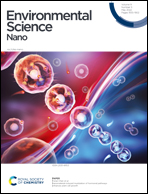Interface engineering of W2C/W2N co-catalyst on g-C3N4 nanosheets for boosted H2 evolution and 4-nitrophenol removal†
Abstract
Heterointerface engineering was adopted to obtain W2C/W2N (WCN) particles via a simultaneous carbonization and nitridation process. High-quality thin g-C3N4 nanosheets (CN) were employed as a platform to establish Schottky heterojunctions. The creation of boosted visible-light absorption, inhibited charge recombination, abundant heterointerfaces, and more active sites together resulted in excellent photocatalytic performance during photocatalytic hydrogen generation and photo-assisted 4-nitrophenol (4-NP) removal. Without Pt as a co-catalyst, the as-prepared WCN/CN-25% sample exhibited a hydrogen generation rate of 1024.6 μmol g−1 h−1, which was 165.3 times higher than that of pristine g-C3N4 and 1.8 times higher than that of g-C3N4/Pt. Under visible light irradiation, the 4-NP removal efficiency was enhanced 43.5-fold compared with pristine g-C3N4. In the presence of sodium borohydride (NaBH4) as a reductant, the dramatically reduced concentration of 4-NP was attributed to the simultaneous hydrogenation-based reduction of 4-NP to 4-aminophenol and the photooxidation of 4-NP. This work provides a new approach for constructing non-noble-metal g-C3N4-based catalysts.



 Please wait while we load your content...
Please wait while we load your content...